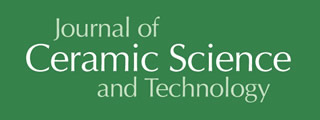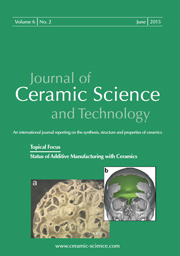Issues
 Journal of Ceramic Science and Technology 2/2014
Journal of Ceramic Science and Technology 2/2014
Vol. 5, No. 2
Topical Issue
Low carbon and carbon-free refractory approaches for advanced steel technologies; A challenge for refractory materials and systems.
Guest Editor:
Christos Aneziris
Preamble
Dear Readers,
Refractories play a key role in all high-temperature applications and cover all the strategic industries such as steel, cement, glass, petrochemicals, energy plants etc. Under the global worldwide faltering economy in the last 15 years the steelmaking industry has triggered refractory makers to improve durability, reliability and workability of refractory materials accompanied by cost reduction. Today the price explosion of raw materials as well as environmental related restrictions challenges the refractory companies as well as the scientific working groups for a continuous development of innovative approaches in material design, material processing and product functionality.
The understanding of their mechanical, thermal, chemical and functional properties as controlled by their structure at nano-, micro- and macro-levels followed by chemical and physical interactions at interfaces/surfaces is an unlimited tool for continuous development and innovation. The focused work of different scientific disciplines under the aspect of applicability is of a great importance to attract young scientists for innovation in this industrial sector. The performance as well as the competitiveness and especially the sustainability of the refractory companies are directly interlinked with the availability of well-educated young engineers by understanding refractories as multifunctional advanced ceramic components.
In 2009 the German Research Foundation (DFG) initiated a six-year Priority Programme SPP 1418 entitled “Refractory Initiation for Lowering Emissions” for applied fundamental research in refractories by bridging different material disciplines and understanding refractories as multi-functional ceramic components. The main goals are lower emissions in high-temperature applications thanks to the impact of refractory innovations such as development of new carbon bonded refractories with less carbon and development of oxide materials with improved thermal shock performance. Nanoengineered refractories, multilayer designs of refractory coarse grain sizes, incorporation of eutectical coarse grains in the refractory matrix etc. are some of the ideas that are supported by new testing approaches as well as simulation and modelling of the microstructure behaviour under thermal shock conditions.
The international community follows these activities, understanding the importance of the DFG’s Priority Programme by generating international congresses under the banner “Refractories Technology to Sustain the Global Environment” (Kyoto, Japan 2011), “Refractories Serving the Low-Carbon Economy” (Zhengzhou, China 2012) as well as “Refractories Solutions Through Innovations” (Calcutta, India, 2014) this year.
At this point I would like to thank all authors as well as review members, who promote innovation in refractories worldwide under an industrially oriented educational engineering umbrella. Enjoy the contributions and especially the visions to meet the new challenges in the high temperature sector based on ECO-Multifunctional Refractories.
C.G. Aneziris
Institute of Ceramic, Glass and Construction Materials, TU Bergakademie Freiberg
Future Research in Refractories: A Roadmap Approach A. Geigenmüller, H. Spindler, K. Lenk, C. G. Aneziris Vol. 5, No. 2, Pages 71-76 DOI: 10.4416/JCST2013-00032 Keywords: Roadmap, strategic planning, refractories, materials synthesis, preparation, processing, testing, modeling and simulation |
Influence of Temperature Dependence of Bulk Modulus on Crack Propagation Velocity D. Pilipenko, Y. Natanzon, H. Emmerich Vol. 5, No. 2, Pages 77-82 DOI: 10.4416/JCST2013-00033 Keywords: Fracture mechanics, fatigue and cracks, high-temperature ceramics, computational methods in continuum mechanics, multiscale modeling |
Numerical Two-Scale Simulations of Damage Evolution at Refractory Materials D. Henneberg, A. Ricoeur Vol. 5, No. 2, Pages 83-92 DOI: 10.4416/JCST2013-00034 Keywords: |
Synthesis of LaCrO3 and La0.9Ca0.1CrO3 by Modified Glycine Nitrate Process A. Bonet, N. Travitzky, P. Greil Vol. 5, No. 2, Pages 93-100 DOI: 10.4416/JCST2013-00024 Keywords: Lanthanum chromite, modified glycine nitrate process, combustion synthesis |
Experimental Characterization and Thermomechanical Modelling of Microstructure Interactions in Cellular Carbon Magnesia Refractories G. Falk, A. Jung, W. da Silveira, S. Diebels Vol. 5, No. 2, Pages 101-114 DOI: 10.4416/JCST2013-00029 Keywords: Porous carbon, thermal shock, FEM modelling |
Low-Carbon Carbon-Bonded Alumina Refractories for Functional Components in Steel Technology V. Stein, C. G. Aneziris Vol. 5, No. 2, Pages 115-124 DOI: 10.4416/JCST2013-00036 Keywords: Alumina, graphite, electron transfer |
Magnesium Aluminate Spinel Ceramics Containing Aluminum Titanate for Refractory Applications K. Moritz, C.G. Aneziris, D. Hesky, N. Gerlach Vol. 5, No. 2, Pages 125-130 DOI: 10.4416/JCST2013-00037 Keywords: Refractories, magnesium aluminate spinel, aluminum titanate, thermal shock resistance |
Crack Formation and Shape of Fracture Surface in Tabular-Alumina-Based Castables with Addition of Specific Aggregates J. Schnieder, L. Lynen, N. Traon, T. Tonnesen, R. Telle Vol. 5, No. 2, Pages 131-136 DOI: 10.4416/JCST2013-00039 Keywords: Refractories, microstructure analysis, eutectic aggregates, thermal shock |
Manufacture of Rotationally Symmetric Multilayer Refractory Devices for Steel Casting Applications by Spiral Winding of Ceramic Green Tapes D. Jakobsen, R. Hammerbacher, S. Dudczig, T. Fey, A. Roosen Vol. 5, No. 2, Pages 137-144 DOI: 10.4416/JCST2013-00040 Keywords: Keywords: Spiral winding, green tapes, refractories, thermal shock |
Numerical Prediction of Effective Thermal Conductivity of Refractory Materials: Methodology and Sensitivity Analysis R. Zehmisch, C. Demuth, A. Al-Zoubi, M.A.A. Mendes, F. Ballani, S. Ray, D. Trimis Vol. 5, No. 2, Pages 145-154 DOI: 10.4416/JCST2013-00041 Keywords: Effective thermal conductivity, refractory materials, thermal lattice-Boltzmann method, random sequential adsorption, sensitivity analysis |
The Influence of the Coarse Fraction on the Porosity of Refractory Castables J. Fruhstorfer, C.G. Aneziris Vol. 5, No. 2, Pages 155-166 DOI: 10.4416/JCST2013-00043 Keywords: Refractory castables, coarse fraction, flowability, density, pore size distribution |
Dependent Thermo-Mechanical Behavior of Novel Alumina-Based Refractories A. Böhm, C.G. Aneziris, J. Malzbender Vol. 5, No. 2, Pages 167-171 DOI: 10.4416/JCST2014-00001 Keywords: Refractories, ceramics, elastic modulus, fracture, thermal shock |



